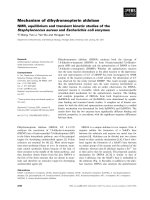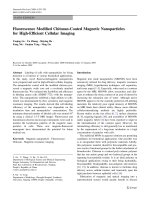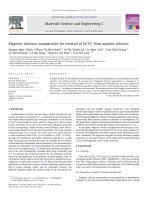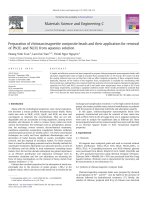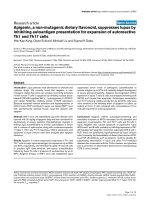Carboxymethyl chitosan functionalized magnetic nanoparticles for disruption of biofilms of straphylococcus aureus and escherichia coli
Bạn đang xem bản rút gọn của tài liệu. Xem và tải ngay bản đầy đủ của tài liệu tại đây (1.64 MB, 76 trang )
CARBOXYMETHYL CHITOSAN-FUNCTIONALIZED
MAGNETIC NANOPARTICLES FOR DISRUPTION OF
BIOFILMS OF STAPHYLOCOCCUS AUREUS AND
ESCHERICHIA COLI
CHEN TONG
(B. ENG DUT)
A THESIS SUBMITTED FOR
THE DEGREE OF MASTER OF ENGINEERING
DEPARTMENT OF CHEMICAL AND BIOMOLECULAR ENGINEERING
NATIONAL UNIVERSITY OF SINGAPORE
2012
DECLARATION
I hereby declare that this thesis is my original work and it has
been written by me in its entirety. I have duly acknowledged all
the sources of information which have been
used in the thesis.
This thesis has also not been submitted for any degree in any
university previously.
Chen Tong
25 Jan 2013
ACKNOWLEDGEMENT
It is a great pleasure to thank many people whose help and suggestions were so
valuable in my one year research work. First and foremost, I would like to express my
sincerest and deepest appreciation to my supervisors, Professor Neoh Koon-Gee and
Professor Kang En-Tang, at National University of Singapore, for their invaluable
guidance, instructions, and discussion throughout this work. Professor Neoh’s
abundant knowledge in biology related areas is always a source of inspiration to me in
carrying out this project. Their enthusiasm, diligence, patience, and preciseness
enlighten me on the road of scientific research, and even my future road of life.
I am also indebted to Dr. Shi Zhilong, Dr. Liu Gang, Dr. Li Min, Cai Tao, Yang
Wenjing, Xu Liqun, Wang Rong, for their fruitful discussion and comments during
this work. I would like to express my particular gratitude to Xu Liqun, from whose
generous consultation and invaluable experience I learnt heavily for my own work.
In addition, my parents, Mr. Chen Dongsheng and Ms. Sun Yulan also gave me great
support during this one year study in Singapore. Their unconditional love and
sacrifice made me fully concentrate on my research work without concerning too
much about the daily issues. Their consistent care and support enable me healthy
enough, both mentally and physically, to finish this work.
Last but not least, I would like to appreciate the financial support provided by the
National University of Singapore.
i
TABLE OF CONTENTS
ACKNOWLEDGEMENT ............................................................................................. i
TABLE OF CONTENTS .............................................................................................. ii
SUMMARY ................................................................................................................. iv
NOMENCLATURE .......................................................................................................v
LIST OF FIGURES .................................................................................................... vii
CHAPTER 1 INTRODUCTION ...................................................................................1
CHAPTER 2 LITERATURE REVIEW.........................................................................5
2.1 Biofilm ................................................................................................................................ 6
2.1.1 Formation and development of biofilm ................................................................... 6
2.1.2 The mechanisms of resistance to antibiotics ........................................................... 7
2.1.3 Infectious diseases................................................................................................... 9
2.1.4 Disruption of biofilm............................................................................................. 10
2.2 Chitosan ............................................................................................................................ 11
2.2.1 Physical and chemical characterization ................................................................. 13
2.2.2 Antimicrobial action .............................................................................................. 14
2.2.3 Applications of chitosan ........................................................................................ 18
CHAPTER 3 EXPERIMENTIAL ...............................................................................21
3.1 Materials ........................................................................................................................... 22
3.2 Synthesis of carboxymethyl chitosan ................................................................................ 22
3.3 Synthesis of magnetic iron oxide nanoparticles (MNPs) .................................................. 23
3.4 Synthesis of magnetic carboxymethyl chitosan nanoparticles (CMCS-MNPs) ................ 23
3.5 Determination of antibacterial effcacy against planktonic cells ........................................ 25
3.6 Determination of biofilm disruption efficacy .................................................................... 26
3.7 Bacterial quantification ..................................................................................................... 29
3.8 Cytotoxicity of nanoparticles ............................................................................................ 29
3.9 Characterization ................................................................................................................ 30
CHAPTER 4 RESULTS AND DISCUSSIONS ..........................................................31
ii
4.1 Characterization of CMCS-MNPs .................................................................................... 32
4.2 Antibacterial efficacy against planktonic cells .................................................................. 35
4.3 Biofilms disruption ........................................................................................................... 38
4.4 Cytotoxicity of nanoparticles ............................................................................................ 47
CHAPTER 5 CONCLUSION AND RECOMMENDATIONS ...................................49
5.1 Conclusion ........................................................................................................................ 50
5.2 Recommendations ............................................................................................................. 51
REFERENCES ............................................................................................................53
iii
SUMMARY
Bacteria in biofilms are much more resistant to antibiotics and microbicides compared
to their planktonic stage. Thus, to achieve the same antibacterial efficacy, a much
higher dose of antibiotics is required for biofilm bacteria. However, the widespread
use of antibiotics has been recognized as the main cause for the emergence of
antibiotic-resistant microbial species, which has now become a major public health
crisis globally. In this work, we present an efficient non-antibiotic-based strategy for
disrupting biofilms using carboxymethyl chitosan (CMCS) coated on magnetic iron
oxide nanoparticles (CMCS-MNPs). CMCS-MNPs demonstrate strong bactericidal
activities against both Gram-positive Staphylococcus aureus (S. aureus) and
Gram-negative Escherichia coli (E. coli) planktonic cells. More than 99% S. aureus
and E. coli planktonic cells were killed after incubation with CMCS-MNPs for 10 h
and 5 h, respectively. In the presence of a magnetic field (MF), CMCS-MNPs can
effectively penetrate into both S. aureus and E. coli biofilms, resulting in a reduction
of viable cells counts by 84% and 95%, respectively, after 48 h incubation, compared
to the control experiment without CMCS-MNPs or CMCS. CMCS-MNPs are
non-cytotoxic towards mammalian cells and can potentially be a useful antimicrobial
agent to eliminate both planktonic and biofilm bacteria.
iv
NOMENCLATURE
ATCC
American type culture collection
CH
Chitosan
CLSM
Confocal laser scanning microscopy
CMCS
Carboxymethyl chitosan
E. coli
Escherichia coli
DMEM
Dulbecco’s modified eagle’s medium
FAC
Ferric ammonium citrate
FTIR
Fourier transform infrared spectroscopy
GV
Gentian violet
LPS
Lipopolysaccharide
LTA
Lipoteichoic acid
MTT
3-(4, 5-dimethylthiazol-2-yl)-2, 5-diphenyltetrazolium bromide
MNP
Magnetic nanoparticle
NIR
NIR diode otopathogenic
OM
Outer membrane
OPPA8
Otopathogenic pseudomonas aeruginosa
PA
Pseudomonas aeruginosa
PDA
Polydopamine
PG
Peptidoglycan
PNIPAAm
Poly(N-isopropylacrylamide)
v
P. mirabilis
Proteus mirabilis
PP
Polypropylene
S. aureus
Staphylococcus aureus
SEM
Scanning electron microscopy
SW
Q-switched Nd-YAGSW
TA
Teichoic acid
TGA
Thermogravimetric analysis
XPS
X-ray photoelectron spectroscopy
vi
LIST OF FIGURES
Figure 2-1
Biofilm maturation is a complex developmental process involving five
stages
Figure 2-2
Three hypotheses for mechanisms of antibiotic resistance in biofilms
Figure 2-3
Structures of chitin and chitosan
Figure 2-4
Schematic diagram illustrating synthesis of carboxymethyl chitosan
Figure 2-5
Schematic view of the Gram-negative cell envelope
Figure 2-6
Gram-positive cell walls
Figure 3-1
Schematic illustration for the preparation of CMCS-MNPs and
RITC-CMCS-MNPs
Figure 3-2
Schematic representation of antibacterial assay using CMCS-MNPs
against planktonic cells
Figure 3-3
Schematic representation of antibacterial assay using CMCS-MNPs
against biofilm
Figure 4-1
FT-IR spectra of (a) MNPs, (b) PDA-MNPs and (c) CMCS-MNPs
Figure 4-2
TGA curves of (a) MNPs, (b) PDA-MNPs and (c) CMCS-MNPs
Figure 4-3
Hydrodynamic size of CMCS-MNPs after incubation in PBS for
different periods
Figure 4-4
Antibacterial effect of CMCS-MNPs (2.0 mg/mL) and CMCS (0.34
mg/mL) on (a) S. aureus and (b) E. coli suspensions (106 cells/mL).
The controls refer to the bacterial suspensions without CMCS or
vii
CMCS-MNPs
Figure 4-5
Antibacterial effect of MNPs (2.0 mg/ml) on (a) S. aureus and (b) E.
coli suspensions (106 cells/mL). The controls refer to the bacterial
suspensions without CMCS or CMCS-MNPs
Figure 4-6
Effect of CMCS-MNPs (with or without MF) and CMCS on pre-grown
(a) S. aureus biofilms and (b) E. coli biofilms after 12, 24, and 48 h.
The controls refer to the respective pre-grown biofilms in sterile PBS
without addition of CMCS or CMCS-MNPs. The prefix 1.0 and 2.0
represent 1.0 mg/mL and 2.0 mg/mL CMCS-MNPs suspension
respectively; and the suffix (MF) indicates the application of magnetic
field in the 5 min period when the biofilms were exposed to the
CMCS-MNPs suspension. * denotes significant differences (p < 0.05)
compared to the control experiment at the same incubation time
Figure 4-7
CLSM (a,c) volume view and (b,d) cross-sectional view images of S.
aureus biofilms exposed to RITC-CMCS-MNPs (2.0 mg/mL) (a,b)
without a MF and (c,d) with a MF. Scale bar = 100 µm
Figure 4-8
CLSM volume view images of (a-c) E. coli biofilms and (d-f) S. aureus
biofilms: (a) and (d) pre-grown biofilms after incubation in PBS for 24
h, (b) and (e) with addition of CMCS-MNPs (2.0 mg/mL) without MF
for 5 min and after incubation in PBS for 24 h, (c) and (f) with addition
of CMCS-MNPs (2.0 mg/mL) with MF for 5 min and after incubation
in PBS for 24 h. Scale bar = 100 µm
viii
Figure 4-9
SEM images of (a-c) E. coli biofilms and (d-f) S. aureus biofilms: (a)
and (d) pre-grown biofilms after incubation in PBS for 24 h, (b) and (e)
with addition of CMCS-MNPs (2.0 mg/mL) without a MF for 5 min
and after incubation in PBS for 24 h, (c) and (f) with addition of
CMCS-MNPs (2.0 mg/mL) with MF for 5 min and after incubation in
PBS for 24 h
Figure 4-10
Viability of 3T3 fibroblast cells incubated for 24 h in growth medium
containing CMCS (0.34 mg/ml) and CMCS-MNPs (2.0 mg/ml) relative
to the control (no CMCS or CMCS-MNPs added). The suffix (MF)
indicates the application of magnetic field throughout the incubation
period. Results are represented as mean ±standard deviation
ix
CHAPTER 1
INTRODUCTION
1
Chapter 1
Introduction
Bacteria growing in biofilms are embedded within a self-produced matrix of
extracelluar polymeric substance (EPS), and thus can be insensitive to antibiotics and
microbicides that could eliminate them in the plankonic state (Branda et al., 2005,
Ramage et al., 2010). In general, biofilm cells are 100- to 1000-fold more resistant to
antibiotic treatment. The resistance mechanisms are associated with the morphology
of the biofilms, whereby the EPS matrix of biofilms can present a generic barrier to
the diffusion of antibiotics. Measurements of antibiotics penetration into biofilms
have shown that some antibiotics cannot readily permeate biofilms (Stewart et al.,
1996). Furthermore, the exchange of genetic materials and the mutation of bacteria in
biofilms occur more frequently than in planktonic populations. Therefore,
development of resistance mechanisms can quickly be selected for and propagated
throughout the community. In addition, the cells in the deep layers of biofilms grow at
a slower rate because of insufficiency of oxygen and nutrients compared to those
located on the surface, and they become insensitive to antibiotics due to their reduced
metabolic activities (Richards et al., 2009, Stewart et al., 2001, He et al., 2011). As a
result of these resistance mechanisms, a much higher dosage of antibiotics is required
to achieve the same antimicrobial efficacy on biofilm microbes than on planktonic
ones (Anwar et al., 1990, Costerton et al., 1987, Khoury et al., 1992).
Biofilm-associated infections have become one of the most devastating medical
complications. For instance, the US Centers for Disease Control and Prevention
estimated that healthcare-associated infections were among the top ten leading causes
2
Chapter 1
Introduction
of death in the United States, accounting for 1.7 million infections and 99,000
associated deaths (Klevens et al., 2007). Many antibiotics including penicillin,
methicillin and sulfonamides have been used in the treatment of bacterial infections.
However, the widespread use of antibiotics in the agricultural and biomedical fields
has been identified as the main cause for the emergence of multidrug-resistant
microbes.
Clearly, an antimicrobial strategy which is not antibiotic-based would be desirable for
combating biofilm-associated infections. Lasers have been used for disrupting
biofilms in recent years (Krespi et al., 2008). For instance, the combination of
Q-switched Nd-YAGSW (SW) and NIR diode (NIR) lasers can result in a decrease of
more than 43% of methicillin-resistant Staphylococcus aureus (S. aureus) biofilm
cells (Krespi et al. 2011). However, the need for specialized equipment such as SW
and NIR could be a limitation for the widespread use of these radiation-based
treatment methods. Recently, it was reported that gentian violet (GV) and ferric
ammonium citrate (FAC) possess biofilm disruption properties. After 24 h of
continuous exposure to GV (1225 µmol/L), few live Pseudomonas aeruginosa (PA)
biofilm cells were detected, and FAC at 250 µmol/L significantly decreased the
fluorescence of otopathogenic Pseudomonas aeruginosa (OPPA8) biofilms after 24 h
of exposure (p < 0.03) (Eric et al., 2008). In other investigations, MgF2 nanoparticles
were shown to be capable of penetrating both Escherichia coli (E. coli) and S. aureus
cells, and could restrict the formation of biofilms (Lellouche et al., 2009). Ag-loaded
3
Chapter 1
Introduction
chitosan nanoparticles also show synergistic antimicrobial effect against S. aureus
bacteria (Ali et al., 2011). Nevertheless, the use of MgF2 and Ag may not be
appropriate as they pose possible environmental problems and toxicity to certain
mammalian cells (Mukherjee et al., 2012, Kim et al., 2011).
In this present study, an antimicrobial and anti-biofilm strategy involving the use of
carboxymethyl chitosan (CMCS) coated on polydopamine (PDA) pre-treated
magnetic iron oxide nanoparticles (MNPs) is presented. Chitosan is a cationic
polysaccharide derived from chitin which is commonly extracted from crustacean
shells. Its antibacterial properties (Li et al., 2008, Raafat et al., 2008, Lou et al., 2011)
and biocompatible nature (Ahmadi et al., 2008, Mattanvee et al., 2009) have attracted
considerable interest in recent years. The carboxymethylation of chitosan increases its
solubility in water, and promotes the dispersion of CMCS-coated MNPs in aqueous
media. The increase in –NH3+ groups, resulting from the intra- and intermolecular
interaction between –COOH and –NH2 groups may also enhance the antibacterial
properties of CMCS-coated MNPs (Liu et al., 2001). Our results showed that this
antimicrobial system is highly effective in eliminating planktonic cells of both
Gram-positive S. aureus and Gram-negative E. coli. The use of a magnetic field in
combination with the CMCS-MNPs can also effectively disrupt the biofilms of these
bacteria.
4
CHAPTER 2
LITERATURE REVIEW
5
Chapter 2
Literature Review
2.1 Biofilm
A biofilm is a gathering of bacterial cells enclosed in a self-produced polymeric
matrix composed of extracellular polymeric substances, mainly exopolysaccharides,
proteins and nucleic acids. Biofilms may form on living or non-living surfaces and
can be prevalent in natural, industrial and hospital settings (Hall-Stoodley et al., 2004,
Lear et al., 2012). Biofilm cells often display enhanced tolerance towards antibiotics
and immune responses and they also exhibit an altered phenotype with respect to
growth rate and gene transcription, which are very different from the single-cells in a
liquid medium (Madsen et al., 2012).
2.1.1 Formation and development of biofilm
Biofilms are present on nearly all types of surfaces, ranging from industrial equipment
to surgical implants, medical devices as well as living tissues. The formation of a
biofilm begins with the initial attachment of free-floating microorganisms to surface.
The first colonists adhere to surface initially through weak, reversible adhesion via
van der Waals forces. Those cells can anchor themselves more permanently using cell
adhesion structures such as pili (Karatan et al., 2009), when they are not immediately
separated from the surface. Once the colonization has begun, the cells in biofilms
grow through a combination of cell division and recruitment. The formation of a
biofilm ended with the last step known as development, which may result in an
aggregate cell colony becoming increasingly antibiotic resistant. Figure 2-1 shows a
complex developmental process of biofilm maturation involving five stages: stage 1,
6
Chapter 2
Literature Review
initial attachment; stage 2, irreversible attachment; stage 3, maturation Ⅰ; stage 4,
maturation Ⅱ; stage 5, dispersion. Each stage of development in the diagram is paired
with a photomicrograph of a developing Pseudomonas aeruginosa biofilms. All
photomicrographs are shown to same scale.
Figure 2-1 Biofilm maturation is a complex developmental process involving five stages
(Monroe, 2007)
2.1.2 The mechanisms of resistance to antibiotics
Bacteria growing in biofilms are embedded within a self-produced matrix of
extracelluar polymeric substance (EPS), and thus can be insensitive to antibiotics and
microbicides that could eliminate them in the plankonic state. In addition, this matrix
protects the cells within it and facilitates communication among them through
biochemical signals. Figure 2-2 shows the three main hypotheses for antibiotic
resistance mechanisms in biofilms.
7
Chapter 2
Literature Review
The first hypothesis is the possibility of slow or incomplete penetration of the
antibiotics into the biofilms. Measurements of antibiotics penetration into biofilms in
vitro have shown that some antibiotics readily permeate bacterial biofilms (Stewart et
al., 1996). However, some antibiotics are adsorbed on the biofilm matrix which can
reduce its penetration into the biofilms. This may account for the slow penetration of
aminoglycoside antibiotics (Kumon et al., 1994) since these positively charged agents
bind to the negatively charged polymers in the biofilm matrix.
Secondly, the exchange of genetic materials and the mutation of bacteria in biofilms
occur more frequently than in planktonic populations. Therefore, development of
resistance mechanisms can quickly be selected for and propagated throughout the
community. Some of the bacteria may differentiate into a protected phenotypic state
and become more resistance to antiobics (Tamilvanan, 2010).
The
third
mechanism
of
antibiotic
resistance
is
the
altered
chemical
microenvironment within the biofilms. The depletion of a substrate or accumulation
of an inhibitive waste product may cause some bacteria to enter into a non-growing
state, in which they become insensitive to antibiotics. De Beer et al. (1994) reported
that oxygen can be completely consumed in the surface layers of a biofilm, leading to
anaerobic niches in the deep layers of the biofilms. Aminoglycoside antibiotics, for
instance, are less effective against the same microorganism in anaerobic than in
8
Chapter 2
Literature Review
aerobic conditions (Tack et al., 1985). Local accumulation of acidic waste products
may lead to pH differences between the biofilm surface and the biofilm interior
(Vroom et al., 1999), which could directly antagonise the action of an antibiotic. For
instance, Baudoux et al. (2007) reported that antibacterial activities against
methicillin-susceptible S. aureus decreased 8-fold of oxacillin between pH 7.4 and
5.0.
Figure 2-2 Three hypotheses for mechanisms of antibiotic resistance in biofilms (Stewart et
al., 2001)
2.1.3 Infectious diseases
9
Chapter 2
Literature Review
Biofilms have been found to be involved in a wide variety of microbial infections in
the body, and they account for nearly 80% of all infections. The US Centers for
Desease Control and Prevention reported that biofilm-associated infections were
among the top ten leading causes of death in the United State, accounting for 1.7
million infections and 99,000 associated deaths (Klevens et al., 2007). There are two
main aspects of biofilm-associated infections, common problems such as urinary tract
infections, catheter infections, coating contact lenses, gingivitis, and the less common
but more lethal processes such as endocarditis, infections in cystic fibrosis and
infections of permanent indwelling devices such as joint prostheses and heart valves.
It is apparent that biofilm-associated infections can potentially become one of the
most devastating medical complications, if new and better approaches for combating
them are not implemented.
2.1.4 Disruption of biofilm
Much of work has been done with the purpose of disrupting the biofilms: (1) Laser
and photodynamic treatment have been used to disrupt bacterial biofilms. Krespi et al
(2011) reported that the combination of Q-switched Nd-YAGSW (SW) and NIR
diode (NIR) lasers can result in a decrease of more than 43% of methicillin-resistant S.
aureus biofilm cells. However, the need for specialized equipment such as SW and
NIR could be a limitation for the widespread use of these radiation-based treatment
methods. (2) Gentian violet (GV) and ferric ammonium citrate (FAC) have also been
reported to possess biofilm disruptive activity. After 24 h of continuous exposure to
10
Chapter 2
Literature Review
GV (1225 µmol/L), few live Pseudomonas aeruginosa (PA) biofilm cells were
detected (Eric et al., 2008). FAC at 200 µM caused disruption of PA biofilms after a
5-day incubation period (Musk et al., 2005). (3) Lellouche et al. (2009) demonstrated
that nanosized magnesium fluoride (MgF2) was capable of penetrating E. coli and S.
aureus cells and inhibiting biofilm formation. (4) Magnetic microspheres coated with
Ag nanoparticles-loaded multilayers were also shown to possess significant
bactericidal properties against both Gram-positive Staphylococcus epidermidis and
Gram-negative E. coli bacteria (Lee et al., 2005). Nevertheless, the use of MgF2 and
Ag may not be appropriate as they pose possible environmental problems and toxicity
to certain mammalian cells (Mukherjee et al., 2012, Kim et al., 2011).
In the present work, magnetic iron oxide nanoparticles (MNPs) functionalized with
bactericidal moieties are used for disruption of biofilms. MNPs are iron oxide
particles with diameters between about 1 and 100 nm, and they have attracted
extensive interest in biomedical field due to their superparamagnetic properties,
biocompatibility and lack of toxicity to humans (Hanini et al., 2011, Markides et al.,
2012). With the use of a magnetic field, the functionalized nanoparticles can then be
delivered to specific locations where bacteria were present.
2.2 Chitosan
Chitosan is a cationic polysaccharide derived from chitin, which is commonly
extracted from crustacean shells such as crabs and shrimp, the cuticles of insects, and
11
Chapter 2
Literature Review
the cell walls of fungi. Figure 2-3 shows the structures of chitin and chitosan. Chitin is
the most abundant natural amino polysaccharide (Majeti N. V. R. K., 2000) and
represents the major source of nitrogen accessible to countless living terrestrial and
marine organisms. The antibacterial properties (Li et al., 2008, Raafat et al., 2008,
Lou et al., 2011) and biocompatible nature (Ahmadi et al., 2008, Mattanavee et al.,
2009) of chitosan have attracted considerable interest in recent years. The
carboxymethylation of chitosan increases its solubility in water, and the increase in
−NH3+ groups, resulting from the intra- and intermolecular interaction between
−COOH and −NH2 groups, may also enhance the antibacterial properties of CMCS
(Liu et al., 2001). The aim of the present study is to formulate an antimicrobial and
antibiofilm strategy, and chitosan is considered one of the most promising materials
for this purpose.
OH
Chitin
H3COC
O
NH
HO
O
O
*
HO
H3COC
OH
O
NH
HO
H3COC
OH
*
O
NH
Deacetylation
OH
Chitosan
OH
O
NH2
HO
O
O
*
HO
O
NH2
*
O
HO
NH2
OH
Figure 2-3 Structures of chitin and chitosan (Jayakumar et al., 2010)
12
Chapter 2
Literature Review
2.2.1 Physical and chemical characteristics
Chitosan is a polysaccharide composed of N-glucosamine and N-acetyl-glucosamine
units, in which the number of N-glucosamine units exceeds 50% (Sodhi Rana et al.,
2001). Chitosan has found several applications due to its excellent chemical, physical,
and biological properties, such as biocompatibility, biodegradability, nontoxicity,
adsorptive properties, and most importantly, antimicrobial activity. Some properties of
chitosan such as the degree of N-deacetylation, molecular weight and solubility can,
and to a great extent, influence the antibacterial efficacy.
One of the most important parameter to examine closely is the degree of deacetylation
of chitin. Takahashi et al. (2008) reported that the higher degree of deacetylation, the
higher antibacterial efficacy of chitosan against S. aureus and E. coli bacteria. In
addition, the molecular weight of chitosan can also affect the antimicrobial ability
(Tsai et al., 2006). Viscometry is the simplest and most rapid method for determining
the molecular weight. The constants а and κ in the Mark-Houwink equation have been
determined in 0.1 M acetic acid and 0.2 M sodium chloride solution. The intrinsic
viscosity is expressed as [η] = κMа = 1.81 * 10-3 M0.93, η is the intrinsic viscosity of
chitosan solution and M is the average molecular weight (Kumar, 2000). Chitosan is a
polyelectrolyte in acidic media because of the protonation of the amine (-NH2) groups.
For instance, when chitosan is dispersed in acetic acid solution at different
concentrations the following equilibria have to be considered:
13
Chapter 2
Literature Review
CH3COOH + H2O
CH3COO- + H3O+
Chit-NH2 + H3O+
Chit-NH3+ + H2O
Rinaude et al. (1999) reported that complete solubilization was obtained when the
degree of protonation exceeded 50% and the ([CH3COOH] / [Chit-NH2]) ratio was
0.6. Despite chitosan’s desirable solubility in acid media, its actual use is limited by
the poor solubility in water. A lot of modification techniques and derivatives such as
O-carboxymethyl chitosan, N-carboxymethyl chitosan and O-succinyl chitosan have
been developed to improve its solubility. Among the water-soluble chitosan
derivatives, O-carboxymethyl chitosan (Figure 2-4) is an amphiprotic ether derivative,
containing –COOH groups and –NH2 groups in the molecule. There are many
outstanding properties of O-carboxymethyl chitosan such as non-toxicity,
biocompatibility, antibacterial, and antifungal bioactivity (Jayakumar et al., 2010).
COOH
O
OH
*
O
HO
O
NH2
*
ClCH3COOH, 60OC
*
O
HO
O
*
NH2
Figure 2-4 Schematic diagram illustrating the synthesis of O-carboxymethyl chitosan
2.2.2 Antimicrobial action
The exact mechanisms of antibacterial activities of chitosan and its derivatives are
still unknown. It is known that the antimicrobial activity is influenced by a number of
factors.
14
